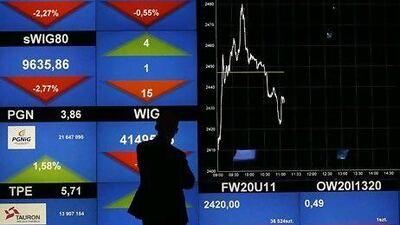As stock markets around the world have been battered in recent weeks, the newspapers have been filled with both bullish and bearish analysis from stock market commentators.
What struck me most was the level of accuracy with which some forecasters were attempting to identify likely turning points in the market using analysis based on fundamentals such as earnings.
For those of you who aren't involved in the day-to-day business of investing money, you may believe it should be possible to tell when stock markets are going to turn.
You may argue that by applying enough intellect, information, computer power and data, there should be a scientific way of achieving every investor's goal of buying low and selling high.
To me, there are many similarities between forecasting stock markets and the weather.
Both can give you a pretty good idea of major changes and what actions you should take, but both have an element of art as well as science and can be influenced by a multitude of exogenous factors that are simply impossible to put into a forecast.
Quite simply, there are too many unknowns to make such predictions with any degree of accuracy.
To see why pinpoint forecasting is impossible, let's look at the best known stock market barometer in the world, the S&P 500 Index.
This index covers 500 of the largest stocks in the US; stocks such as IBM, Goldman Sachs, Johnson & Johnson and Microsoft. In the past month this index has fallen from about 1350 to 1120, a drop of some 17 per cent.
I am now reading comments that the index will hit a particular level: 1050 by year's end, even 1600 by year's end, and 2230 in three years.
To the casual reader, these forecasts appear plausible but some simple arithmetic quickly demonstrates the folly of making such laser-guided predictions.
If someone is forecasting the index will be at 1050 or 1600 by the year end, what are they really saying? Using some simple maths, it becomes clear.
Total earnings per share (EPS) for the index currently stands at US$91.42 (Dh335.78) and next year's estimated profits are $99.77. With the index at a level of 1120, this means that the historic price-to-earnings ratio is 12.25 times (calculated by dividing 1120 by 91.42) and that the market is trading on a forward price-to-earnings ratio of 11.22 times (calculate by dividing 1120 by 99.77).
I will use the forward price-to-earnings ratio for the rest of this article for simplicity's sake.
If we assume that EPS forecasts do not change, then for the index to be trading at a level of 1050, the forward price-to-earnings ratio will need to fall from 11.22 times to 10.5 times.
Similarly, for the index to be trading back up at 1600, the forward price-to-earnings ratio would need to trade at 16 times. Both seem entirely reasonable levels, well within any historic norms.
This shows the problem with forecasting using price-to-earnings valuations. You could make or lose a lot of money from here without the market getting either outrageously cheap or expensive.
Of course, it is not just the price-to-earnings ratio that could change. If, as is likely, forecast EPS starts to fall, then that will have a significant impact on the level of the index.
So what does this mean for investors? For me the clear lesson is that you can't hope to be too accurate.
Tiny changes in your assumptions can make a massive difference to what level the market should be priced at.
This is without even throwing in one-off events such as tsunamis, terrorism, pandemics or political regime change, which are the black swans in these calculations.
You shouldn't hope that markets will turn just because they are cheap or expensive.
In particular, you shouldn't trade just because of a particular valuation level unless it is backed by strong technical signals that suggest that sentiment has gone too far or that selling pressure will soon be exhausted.
I much prefer to seek long-term value. There are currently lots of shares around the world that are trading at less than 1 times sales, less than 5 times free cash flow or with well covered dividends that are in excess of 5 per cent.
Will these shares bounce this week? I don't know. Could they fall further from here? Yes, they could (and almost certainly would) fall much further if markets don't like what they hear from the Federal Reserve and European Central Bank.
In this case, I would happily buy more. If you always remember that you are buying little bits of businesses and should be doing so at prices that are attractive in relation to their future profit streams, you will probably be a successful long-term investor.
Alan Durrant is group chief investment officer and general manager, Asset Management Group, National Bank of Abu Dhabi. The views expressed are his own and not those of the bank

